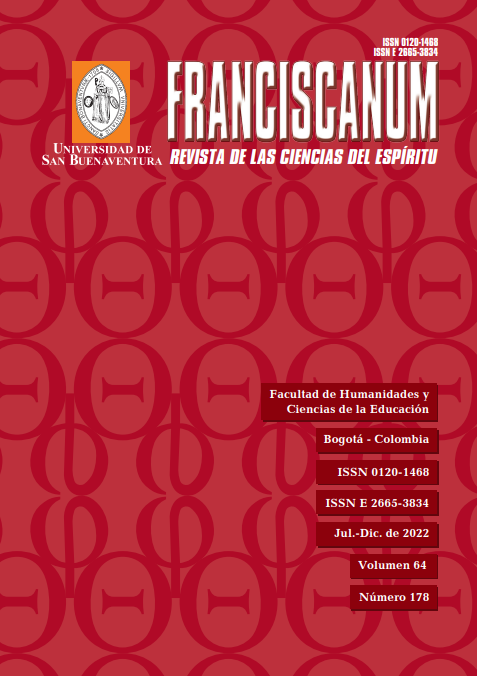This journal provides immediate open access to its content, based on the principle that giving the public free access to research helps a greater global exchange of knowledge.
Therefore, the Creative Commons 4.0 Attribution Attribution - Equal Share (by-sa) License is accepted: The commercial use of the work and the possible derived works is permitted, the distribution of which must be done with a license equal to that regulates the original work.
http://creativecommons.org/licenses/by-sa/4.0/
Along these same lines and in line with the Open Access policy, it is clarified that the authors maintain their rights to articles, without restrictions and, in the same way, they maintain their publication rights, without restrictions. They are only asked to reference the number of the Franciscanum magazine where the article initially appeared.
Abstract
This article is a theoretical study on the similarities between the Gnostic doctrines, which flourished around the second century of our era, and the aesthetic thought of the Russian painter Vasili Kandinsky. The objective is to analyze these two philosophical and spiritual ideas frameworks to expose their similarities and differences. In this way, it will be investigated if, despite the centuries that separate them and the difference in historical contexts that surround them, there may be common existential and philosophical problems at the origins of both doctrinal statements The study will seek, therefore, to elucidate whether it is possible to understand Kandinsky's aesthetics as a special modern structured gnosis through his conceptual and artistic approaches. The results of the research aim not only at shedding light on Kandinsky's originality within the history of art, but also to be useful to highlight and understand some important points of the cultural discussion within which his work is framed.
Keywords:
References
Bell, Daniel. Las contradicciones culturales del capitalismo. Madrid: Alianza, 1992.
Benjamin, Walter. Discursos interrumpidos. Buenos Aires: Taurus, 1989.
Berger, Peter. Los numerosos altares de la modernidad: En busca de un paradigma para la religión en una época pluralista. Salamanca: Sígueme, 2016.
Besançon, Alain. La imagen prohibida: Una historia intelectual de la iconoclasia. Madrid: Siruela, 2003.
Blavatsky, Helena. La voz del silencio y la clave de la teosofía. Madrid: Biblok, 2016.
Borghesi, Massimo. Secularización y nihilismo. Cristianismo y cultura contemporánea. Madrid: Encuentro, 2007.
Brihuega, Jaime. «W. Kandinsky». En Historia de las ideas estéticas y de las teorías artísticas contemporáneas II, editado por Valeriano Bozal, 249-252. Madrid: Machado, 2010.
Culdaut, Francine. El nacimiento del cristianismo y el gnosticismo. Propuestas. Madrid: Akal, 1996.
De Lubac, Henri. La posteridad espiritual de Joaquín de Fiore I. Madrid: Encuentro, 1989.
De Santos Otero, Aurelio. Los evangelios apócrifos. Madrid: BAC, 1991.
Doods, Eric. Paganos y cristianos en una época de angustia. Madrid: Cristiandad, 1975.
Duch, Lluís. Un extraño en nuestra casa. Barcelona: Herder, 2009.
Düchting, Hajo. Wassily Kandinsky: Una revolución pictórica. Madrid: Evergreen, 1996.
García Bazán, Francisco. Gnosis: La esencia del dualismo gnóstico. Buenos Aires: Catañeda, 1978.
Golding, John. Caminos a lo absoluto: Mondrian, Malévich, Kandinsky, Pollock, Newman, Rothko y Still. Madrid: Turner y FCE, 2003.
Gombrich, Ernst. La historia del arte. Londres: Phaidon, 1997.
Henry, Michel. Ver lo invisible: Acerca de Kandinsky. Madrid: Siruela, 2008.
Horkheimer, Max y Theodor Adorno. Dialéctica de la Ilustración: Fragmentos filosóficos. Madrid: Trotta, 2001.
Hughes, Robert. El impacto de lo nuevo. El arte en el siglo XX. Barcelona: Galaxia Gutenberg, 2000.
Jonas, Hans. La religión gnóstica: El mensaje del Dios extraño y los comienzos del cristianismo. Madrid: Siruela, 2003.
Kandinsky, Vasili. De lo espiritual en el arte: Contribución al análisis de los elementos pictóricos. Barcelona: Paidós, 2012.
Kandinsky, Vasili. Escritos sobre arte y artistas. Madrid: Síntesis, 2010.
Kandinsky, Vasili. La gramática de la creación. El futuro de la pintura. Barcelona: Paidós, 2016.
Kandinsky, Vasili. Punto y línea sobre el plano: Contribución al análisis de los elementos pictóricos. Barcelona: Paidós, 2017.
Kandinsky, Vasili y Franz Marc. El jinete azul. Barcelona: Paidós, 2016.
Kojève, Alexandre. Kandinsky. Madrid: Abada, 2007.
Luque, Alberto. Arte moderno y esoterismo. Lleida: Milenio, 2002.
Markschies, Christoph. La gnosis. Barcelona: Herder, 2002.
Martínez Benito, Julia. Kandinsky y la abstracción: Nuevas interpretaciones. Salamanca: Universidad de Salamanca, 2011.
Nancy, Jean Luc. El arte hoy. Buenos Aires: Prometeo, 2014.
Orbe, Antonio. Cristología gnóstica: Introducción a la soteriología de los siglos II y III (Volumen II). Madrid: BAC, 1976.
Péguy, Charles. Nota conjunta sobre Descartes y la filosofía cartesiana. Buenos Aires: Emecé, 1946.
Schopenhauer, Arthur. El mundo como voluntad y representación I. Madrid: Trotta, 2009.
Voegelin, Eric. Ciencia, política y gnosticismo. Madrid: Rialp, 1973.
Weber, Max. La ética protestante y el espíritu del capitalismo. México D. F.: FCE, 2011.

 Perfil Google Scholar
Perfil Google Scholar


















